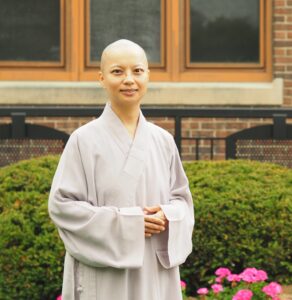
Physical Engagement: A Simple Tea Ritual Changes the Classroom
From a broader aspect, school closure during the outbreak of the Coronavirus pandemic created a crisis in the global history of education. But, personally, this crisis brought about opportunities, and the pros outweighed the cons. When classes moved online, the unexpected challenges of educational disruption inspired me—more precisely, forced me—to have a critical reflection on what exactly multimodal communication means in higher education. This unique moment also made me rethink how and why physical interactions play a critical role in the process of learning. These in-depth reflections have reshaped my teaching styles and pedagogical skills, especially in my Zen Buddhism course.
The lack of physical interactions during the campus closure created more devastating impacts on my Zen Buddhism class than on my other courses. This intermediate-level class guides students to learn thoughts and practices related to mind cultivation in Buddhist meditation traditions in China, Japan, and the United States. I faced a challenging task: students mainly focused on pursuing “good grades” rather than connecting their learning to the real world. Without classroom engagement, students ended up memorizing knowledge rather than developing insights. This issue is worth seriously considering for instructors. I realized that providing students with opportunities for firsthand experience is more significant than teaching them theories described in textbooks or PowerPoint slides.
When we returned to the normative classroom-based environment after the pandemic, I redesigned my course syllabus and included a tea ritual to boost students’ engagement. This change aims to stimulate cognitive abilities and develop a sense of self-awareness.
Lesson Plan:
Students are divided into five groups. Each group selects a “host” to make tea, and other members become the “guests” who experience mindful tea drinking. I explain the procedure of tea making and each student takes turns practicing the etiquette of a “host” who serves tea. Students are required to observe their physical and mental states during the entire process.
After the tea ceremony, each group discusses why tea drinking is a type of mind cultivation and whether the ritual can evoke peace and awareness. The questions that students discuss include:
- How does tea drinking bring about sensory awareness of the whole person (smell, vision, taste, and feeling cold or warm)?
- Why and how does tea drinking denote a “healing journey” from a personal aspect?
- How is tea making as the subject of concentration be unique, when compared with mediation?
- How is tea drinking in the Zen tradition different from other types of drinking culture (for example, coffee)?
During the discussion, I reduce my input to eliminate the “authoritative” voice and remind students that it’s their time to share their self-discovery, which is beyond right or wrong answers. Here is what I have learned from students’ feedback.
Students rediscover their sense of awareness: While comparing tea drinking with meditation, most students respond that the concentration produced by meditation is too subtle to detect. But drinking a cup of tea can stimulate multiple sensations such as smell, taste, and physical feeling. Because tea is visible, touchable, and noticeable, students feel it is easier to bring their mind and body together. Students said that they are able to perceive the whole body as a learning tool. Through the integration of physical engagement in learning, students acknowledge that bringing body and mind together is the key to producing insights.
Limitation of language: When students discuss and share their feelings, they find out that language has certain limitations and their sensations and states of mind are ineffable and beyond language. Some students struggle to find words to express their feelings. A student said that seeing the world through the lens of “ritual” is very distinct from that of “textbook.” All students agree that this activity diversifies their learning resources and supports other modes of learning such as reading or writing papers.
Daily activities create opportunities for spiritual cultivation: This activity enables students to extend the tea-drinking experience to reflect on their other daily routines. Students report that a five-minute tea drinking is a doable and manageable daily opportunity for stress reduction. Students also mention that the quiet moment is a time of mental purification, and they hope to create more occasions to do so. A student suggests that the college should consider providing free tea ceremonies at quiet locations around campus to improve student self-awareness and relaxation during break time, especially the midterm and final exam week.
This teaching experience is meaningful and rewarding because I see smiles on students’ faces.
Leave a Reply